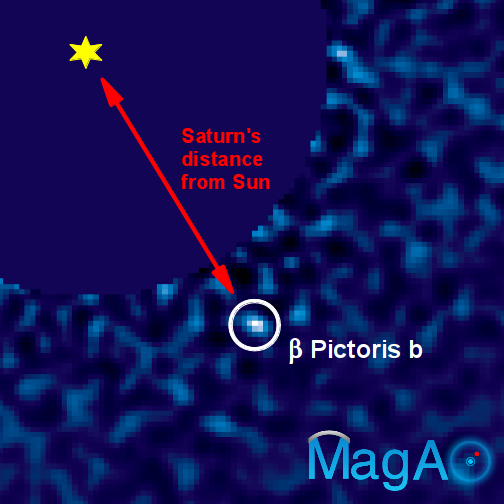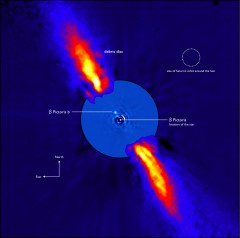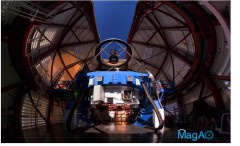
The advent of digital photography and the development of digital imaging technologies like Charged Coupled Devices, or CCDs, have made digital cameras the method of choice for amateur and professional astronomers alike when it comes to capturing the beauty of the night sky. Now, in what constitutes a step forward in the direct imaging of exoplanets, astronomers have used this technology to capture the light from an alien world in visible wavelengths for the first time, with a CCD camera mounted on top a ground-based telescope.
Obtaining direct images of other worlds around distant stars has been one of the biggest technical challenges in astronomy. Lost in the intense glare of their host stars, exoplanets are extremely difficult to be resolved in visible light. “If our Solar System were viewed from 70 light-years away (average for a nearby star), Jupiter would appear roughly a billion times fainter than our Sun with a separation on the sky comparable to the size of a dime viewed from 5 miles away,” writes Sasha Hinkley, an astronomy and astrophysics postdoctoral fellow at the California Institute of Technology’s Department of Astronomy, in Pasadena, Calif.
The several dozens of exoplanets that have been directly imaged by astronomers, out of the thousands that have been discovered to date, have been observed in infrared wavelengths instead, through the detection of their thermal radiation. One limitation of this method is that it can spot only very massive, young, and hot worlds that are still radiating away the left-over heat of their formation. In addition, this method works best for observing planets in very wide orbits, allowing for their light to be more easily resolved from the overwhelming glare of their host stars. In order to directly image an Earth-like exoplanet inside the habitable zone of its star, where conditions could be optimal for the development of life as we know it, astronomers would have to look at visible wavelengths—such an Earth-analog world would be too small and cold to be observed in the infrared.

An international team of astronomers have recently made a very important step toward this goal, by imaging the visible light of an exoplanet around Beta Pictoris, an A-type star 1.75 times more massive than the Sun, located 63.4 light-years away in the southern constellation Pictor. Astronomers had confirmed the existence of the exoplanet called Beta Pictoris b, in 2008, through direct imaging in infrared light with ESO’s Very Large Telescope in Chile, by observing the planet’s motion inside the protoplanetary disk of material surrounding its parent star. These observations had revealed Beta Pictoris b to be a massive gas giant, with a mass 12 times that of Jupiter and orbiting its star at a distance of approximately 8-10 Astronomical Units away—an orbit comparable to that of Saturn in our Solar System.
The visible-light image of Beta Pictoris b was obtained with the Magellan Adaptive Optics System, or MagAO, that is mounted on top of the 6.5-m Magellan II telescope at the Las Campanas Observatory in Chile. Adaptive optics, a technology widely used in astronomy for decades, cancels out the blurring effects of the Earth’s atmosphere by continuously adjusting the shape of deformable mirrors of ground-based telescopes thousands of times every second in real-time with millisecond accuracy, thus allowing for angular resolutions that rival those of space-based instruments. “We can, for the first time, make long-exposure images that resolve objects just 0.02 arcseconds across – the equivalent of a dime viewed from more than a hundred miles away,” says Dr. Laird Close, a professor at the University of Arizona’s Department of Astronomy and head of the team that designed the MagAO system. “At that resolution, you could see a baseball diamond on the Moon.”
The system designed by Close and his team features two cameras: the VisAO, for observing at visible and near-infrared wavelengths between 0.5 and 1 μm, and the Clio2 for observing at the near and mid-infrared between 1 and 5 μm. The VisAO camera was used to obtain the visible-light image of Beta Pictoris b. “This is an important next step in the search for exoplanets, because imaging in visible light instead of infrared, is what we likely have to do if we want to detect planets that might be suitable for harboring life,” says Jared Males, a NASA Sagan Fellow at Steward Observatory at the University of Arizona and member of the MagAO team.

In order to confirm that what they were seeing in visible light was indeed Beta Pictoris b, the astronomers simultaneously imaged the planet in infrared wavelengths with Clio2 to rule out the possibility that the VisAO results were due to artifacts or noise in the data. “An important part of the signal processing is proving that the tiny dot of light is really the planet and not a speckle of noise,” says Katie Morzinski, also a NASA Sagan Fellow from the Center for Adaptive Optics at the University of California, Santa Cruz, and member of the MagAO team. “I obtained the second image in the infrared spectrum – at which the hot planet shines brightly – to serve as an unequivocal control that we are indeed looking at the planet. Taking the two images simultaneously helps to prove the [visible-light] planet image on the CCD is real and not just noise.”
The imaging of Beta Pictoris b in visible wavelengths really stretched the observing capabilities of today’s ground-based telescopes to the limit. “Because the Beta Pictoris system is 63.4 light years from Earth, the scenario is equivalent to imaging a dime next right next to a lighthouse beam from more than four miles away,” says Males. “Our image has the highest contrast ever achieved on an exoplanet that is so close to its star.” Close’s team was also aided by the fact that the exoplanet is a massive “hot Jupiter” many times bigger than the Earth and located far enough from its star to still be detectable, despite the limitations of today’s instruments. “In our case, we were able to record the planet’s own glow because it is still young and hot enough so that its signal stood out against the noise introduced by atmospheric blurring,” adds Maels. “But when you go yet another 100,000 times fainter to spot much cooler and truly Earth-like planets, we reach a situation in which the residual blurring from the atmosphere is too large and we may have to resort to a specialized space telescope instead.”
Although the imaging of an Earth-analog exoplanet in visible light is beyond the scope of ground-based instruments today, the exciting work made by Close’s team nevertheless opens the door for a similar method to be applied by more advanced space telescopes in the future, to finally provide us with our first glimpses of an alien version of the “pale blue dot,” serenely orbiting a star somewhere inside the Milky Way galaxy. “Our ultimate goal is to be able to image what we call ‘pale blue dots’,” says Close. “After all, the Earth is blue. And that’s where you want to look for other planets: in reflected [visible] blue light.”
Such an image could come from the Starshade exoplanet direct-imaging mission whose concept has been recently revived by NASA for further study. Yet, aside from the difficult engineering challenges facing its design, it is uncertain whether the space agency can receive the funding required for such a mission, in light of the current fiscal environment and the continuing cuts in NASA’s Science Mission Directorate budgets in recent years. As with every other area of space science and exploration, exciting discoveries will probably have to wait for better times, both politically and financially.
The results of Close’s team’s observations are detailed in a study that has been accepted for publication by the Astrophysical Journal.
Video Credit: NASA/JPL
Want to keep up-to-date with all things space? Be sure to “Like” AmericaSpace on Facebook and follow us on Twitter: @AmericaSpace




We are on the cusp of yet untold discoveries! All the more reason to have a comprehensive and aggressive planetary space program.